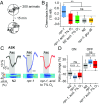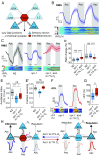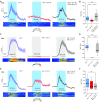Memory of recent oxygen experience switches pheromone valence in Caenorhabditis elegans
- PMID: 28373553
- PMCID: PMC5402444
- DOI: 10.1073/pnas.1618934114
Memory of recent oxygen experience switches pheromone valence in Caenorhabditis elegans
Abstract
Animals adjust their behavioral priorities according to momentary needs and prior experience. We show that Caenorhabditis elegans changes how it processes sensory information according to the oxygen environment it experienced recently. C. elegans acclimated to 7% O2 are aroused by CO2 and repelled by pheromones that attract animals acclimated to 21% O2 This behavioral plasticity arises from prolonged activity differences in a circuit that continuously signals O2 levels. A sustained change in the activity of O2-sensing neurons reprograms the properties of their postsynaptic partners, the RMG hub interneurons. RMG is gap-junctionally coupled to the ASK and ADL pheromone sensors that respectively drive pheromone attraction and repulsion. Prior O2 experience has opposite effects on the pheromone responsiveness of these neurons. These circuit changes provide a physiological correlate of altered pheromone valence. Our results suggest C. elegans stores a memory of recent O2 experience in the RMG circuit and illustrate how a circuit is flexibly sculpted to guide behavioral decisions in a context-dependent manner.
Keywords: acclimation; experience-dependent plasticity; neural circuit; oxygen sensing; tonic circuit.
Conflict of interest statement
The authors declare no conflict of interest.
Figures








Similar articles
-
Ascaroside Pheromones: Chemical Biology and Pleiotropic Neuronal Functions.Int J Mol Sci. 2019 Aug 9;20(16):3898. doi: 10.3390/ijms20163898. Int J Mol Sci. 2019. PMID: 31405082 Free PMC article. Review.
-
Decoding a neural circuit controlling global animal state in C. elegans.Elife. 2015 Mar 11;4:e04241. doi: 10.7554/eLife.04241. Elife. 2015. PMID: 25760081 Free PMC article.
-
A hub-and-spoke circuit drives pheromone attraction and social behaviour in C. elegans.Nature. 2009 Apr 30;458(7242):1171-5. doi: 10.1038/nature07886. Epub 2009 Apr 6. Nature. 2009. PMID: 19349961 Free PMC article.
-
Dissection of neuronal gap junction circuits that regulate social behavior in Caenorhabditis elegans.Proc Natl Acad Sci U S A. 2017 Feb 14;114(7):E1263-E1272. doi: 10.1073/pnas.1621274114. Epub 2017 Jan 31. Proc Natl Acad Sci U S A. 2017. PMID: 28143932 Free PMC article.
-
Molecular mechanism for trimetric G protein-coupled thermosensation and synaptic regulation in the temperature response circuit of Caenorhabditis elegans.Neurosci Res. 2013 Jul;76(3):119-24. doi: 10.1016/j.neures.2013.03.008. Epub 2013 Mar 28. Neurosci Res. 2013. PMID: 23542220 Review.
Cited by
-
Molecular physiology regulating cold tolerance and acclimation of Caenorhabditis elegans.Proc Jpn Acad Ser B Phys Biol Sci. 2022;98(3):126-139. doi: 10.2183/pjab.98.009. Proc Jpn Acad Ser B Phys Biol Sci. 2022. PMID: 35283408 Free PMC article.
-
A primer on pheromone signaling in Caenorhabditis elegans for systems biologists.Curr Opin Syst Biol. 2019 Feb;13:23-30. doi: 10.1016/j.coisb.2018.08.012. Epub 2018 Aug 31. Curr Opin Syst Biol. 2019. PMID: 30984890 Free PMC article.
-
Ascaroside Pheromones: Chemical Biology and Pleiotropic Neuronal Functions.Int J Mol Sci. 2019 Aug 9;20(16):3898. doi: 10.3390/ijms20163898. Int J Mol Sci. 2019. PMID: 31405082 Free PMC article. Review.
-
Cold acclimation via the KQT-2 potassium channel is modulated by oxygen in Caenorhabditis elegans.Sci Adv. 2019 Feb 6;5(2):eaav3631. doi: 10.1126/sciadv.aav3631. eCollection 2019 Feb. Sci Adv. 2019. PMID: 30775442 Free PMC article.
-
Social and sexual behaviors in C. elegans: the first fifty years.J Neurogenet. 2020 Sep-Dec;34(3-4):389-394. doi: 10.1080/01677063.2020.1838512. Epub 2020 Nov 4. J Neurogenet. 2020. PMID: 33146579 Free PMC article.
References
-
- Saeki S, Yamamoto M, Iino Y. Plasticity of chemotaxis revealed by paired presentation of a chemoattractant and starvation in the nematode Caenorhabditis elegans. J Exp Biol. 2001;204:1757–1764. - PubMed
-
- Kindt KS, et al. Dopamine mediates context-dependent modulation of sensory plasticity in C. elegans. Neuron. 2007;55:662–676. - PubMed
-
- Hoopfer ED. Neural control of aggression in Drosophila. Curr Opin Neurobiol. 2016;38:109–118. - PubMed
Publication types
MeSH terms
Substances
Grants and funding
LinkOut - more resources
Full Text Sources
Other Literature Sources
Medical
Miscellaneous

